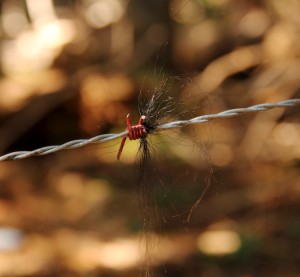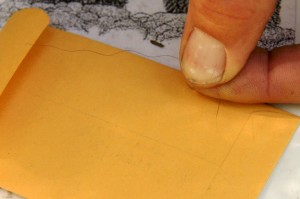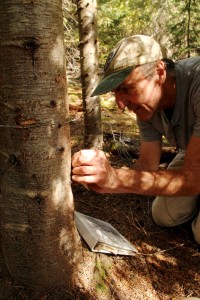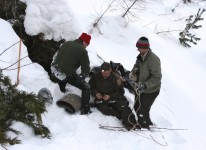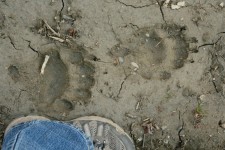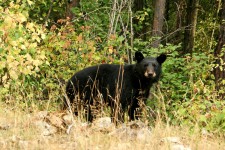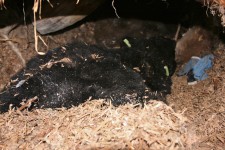Curiosity grew as we followed the flagging to the research site above Cow Creek. Did grizzly bears visit the site during the last month or just the cattle whose tracks we were following?
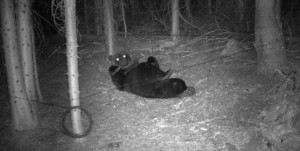
A trail camera captured a grizzly bear rolling around inside of a corral site. The bear managed to cross the barbed wire without leaving any hair but left some on the ground. Photo courtesy of IDFG
Arriving at the research site was like arriving at a mini-horse corral–barbed wire strung knee-high in a rough square around trees and a trail camera nearby. I was excited to find out who left hair on the barbed wire and evidence on the trail camera.
Don Gay, an Idaho Fish and Game technician, retrieved the memory card from the camera to look at the photos. The first few pictures we looked at with great scrutiny and excitement–a possible grizzly bear. A larger screen would be needed to see the details of the claws. Then followed black bears, a mountain lion, deer and cattle–lots of cattle.
For two years, Gay has been maintaining research sites and during that time he has seen a lot of animals besides bears on the trail cameras–great gray owls, wolves, bobcats, cougars, deer, elk, moose, snowshoe hares and the occasional person.
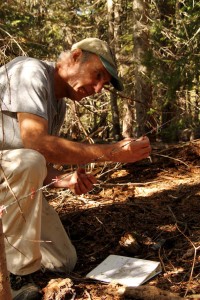
IDFG technician Don Gay meticulously checks each barb for grizzly bear hair at a research site near Cow Creek.
In addition to showing whether a grizzly bear has visited the site, the trail cameras help Gay know if a certain tree was rubbed against so he can check the tree for hair.
Whether there is a photo of a grizzly bear or not on the camera (because it doesn’t always work), Gay methodically checks the barbs on the barbed wire. Holding a piece of paper behind each barb, he checks each barb and places an envelope beneath the barbs with hair.
Then Gay goes back around and plucks the hair from the marked barbs, examining each hair to see if it is a grizzly hair—dark with a light-tip. All the hairs collected are placed in marked envelopes–black bear or grizzly bear.
Envelopes with grizzly bear hair are sent to a lab for DNA analysis. If the trail camera indicates a grizzly bear was at the site, then all the envelopes from the site are sent to the lab. If only a black bear was recorded and black bear hair found, the envelopes are filed away–potentially for a graduate student research project on the black bears of the Selkirk Mountains.
Unfortunately, none of the barbs held definite grizzly bear hair at this site. Gay then referred back to the trail camera and looked at where the potential grizzly bear had been rolling around within the corral.
Then getting down on his hands and knees, Gay examined every chunk of wood or bark to see if a hair was snagged on it. After several minutes, he finally found one hair.
“One good hair is all it takes,” said Gay, happy to have found a hair.
As he continued scouring the ground, he found more and more grizzly bear hair. Gay shared the piece of knowledge that bear hair doesn’t snap when pulled like ungulate (moose, elk, deer) hair because it isn’t hollow.
Once Gay was finished looking on the ground for hair he began taking down the wire and found hair on a tree–more grizzly bear hair! Even though no photo on the trail camera showed the grizzly bear rubbing on the tree, the light tip indicated the hair was from a grizzly bear.
Every time Gay checked the hair snare sites, he moved them at least half-a-mile away or took them down. On this trip in late September, he was removing the site for the season. During the rest of the summer, he would move the barbed wire to another site within the research cell.
Last year, Gay set hair snare sites based on GPS coordinates given to him by Wayne Wakkinen, IDFG Panhandle Region wildlife manager, and the grizzly bear trapping crews on where grizzly bears might visit.
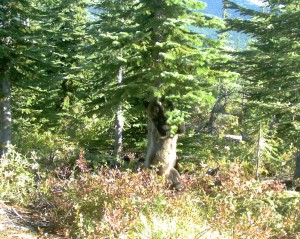
Hair for the DNA project is also collected from trees that grizzly bears rub against. Photo courtesy of IDFG
This year general locations were based on habitat quality. The Selkirk Mountains were divided into three-by-three mile grid cells and colored based on habitat quality for grizzly bears. Gay looked for the highest ranked areas within designated grid cells and found the best area with reasonable access to set up a hair snare site.
Additionally, Gay had to make sure sites were at least 100 yards from a trail and 500 yards from an open road.
Potential sites had to be on level or evenly sloped ground so all the barbed wire was 18 inches off the ground. Then four trees big enough to support wire and spaced at the right distance apart had to be located. Another criteria was a tree for the trail camera–far enough away to take a photo of the whole corral and surrounding area.
Some animals would approach the corral but not enter so the trail camera was the only way of knowing if a grizzly bear visited but didn’t cross the wire. Some grizzly bears may know what the smell of the corral is all about and just sniff around.
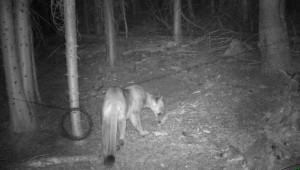
Each research site is baited with a cow blood mixture that attracts grizzly bears and other animals such as mountain lions. Photo courtesy of IDFG
Other bears that hadn’t encountered the corral sites before were tempted by the smell of the lure (cow blood mixed with other components like fish) and crossed the barbed wire to investigate the smell.
When Gay would reset the hair snare sites, he would pour the lure mixture on decomposing wood which acts like a sponge and keeps the site smelly as long as possible.
To encourage repeat visits, the additional components in the cow blood were changed so each batch smelled different.
Previous studies in the Cabinet-Yaak area determined that visitation rates declined on sites that were re-lured and not moved. Therefore, Gay moved his corral sites every time he checked them.
This year, Gay had ten grid cells active all season (mid-May through September) and 50 corrals total. In areas with high habitat quality such as Cow Creek, there were four different sites over the summer. Gay was thankful this year he was only on the east side of the Selkirks since last year he managed sites on both the east and west sides.
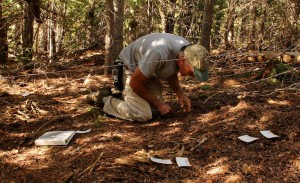
Don Gay carefully checks the ground for any grizzly bear hair left behind by a bear rolling in the lure.
Most of Gay’s sites were on State and private timber land this year with only a few on U.S. Forest Service land. Gay was appreciative that Hancock Timber Resource Group, Molpus Woodlands Group, Stimson Lumber Company and IDL were cooperative with him setting up sites on their land–especially during the height of fire restrictions.
Several other people and agencies participated in managing hair snare sites this year. The U.S. Forest Service managed sites in Bog Creek, Grass Creek and the Pack River drainage. Other people managed sites in Boundary Creek, Boundary Creek Wildlife Management Area, and the west side of the Selkirk Mountains.
Between everybody maintaining hair snare sites as of mid-September, at least 30 grizzly bears had visited the sites. Whether or not some were the same bears will be revealed in the DNA analysis.
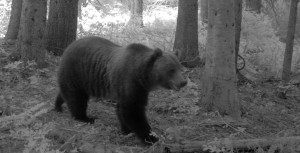
A grizzly bear walks past a research site in the Cabinet Mountains near Divide Lake. Don Gay maintained a few sites in the Boulder Creek area to scope out the potential for trapping. Photo courtesy of IDFG
Gay is anxious for this year’s DNA analysis results to see if he saw six different bears or three of the same bears on the ridge between Beaver Creek and Cow Creek. Over the summer his trail cameras captured photos of one grizzly bear at a lower site, two grizzly bears at a higher elevation site and then three grizzly bears at another site. Whether or not they were all different bears is a matter of DNA testing.
Last year’s DNA results came back this summer. One of the interesting results was that one of the bears was a descendent of a male from the Cabinet Mountains.
“It’s nice finding movement between the two populations [Cabinet and Selkirk] and genetic interchange,” said Gay.
The DNA collected from the hair snare sites helps establish a lineage of grizzly bears in the Selkirk Mountains and helps see which mothers and fathers are missing from the data bank.
Grizzly bears in the Selkirk Mountains have a unique genetic signature compared to grizzly bears in the Cabinet Mountains. A study in the Cabinet/Yaak ecosystem revealed one male from the Selkirk Mountains moved to the West Cabinets.
While the DNA collected from the hair snare sites doesn’t provide a population estimate, it does help contribute to the knowledge of the minimum number of grizzly bears in the Selkirk Mountains.
For more population information, Idaho Fish and Game and the U.S. Fish and Wildlife Service trap grizzly bears to attach collars (taking DNA samples at the same time), download GPS collar data by airplane, set up camera-only sites and smaller hair snare sites. The smaller hair snare sites are barbed wire on trail signs, bridge posts, and well-visited bear rub trees.
All the combined information provides a minimum number of grizzly bears and also information for other recovery goals such as the number of females with cubs. For example, researchers previously only saw an average of one female grizzly with cubs each year but with the trail cameras last year at least four females with cubs were recorded.
A more intensive study would be needed to provide a population estimate of grizzly bears in the Selkirk Mountains said Gay.
For this year though, Gay is anxious to see if they received more grizzly bear visits from placing hair snare sites in high habitat quality areas versus the subjective method they used last year. The curiosity of knowing keeps Gay excited to check each and every barb on the wire and if necessary, every chunk of wood on the ground.

